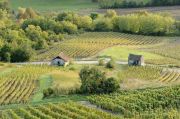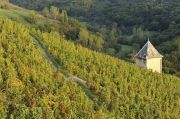 |
 |
Bugey AOC, little-known but worth discovering |
 |
One of the best-kept secrets of the French wine scene, Bugey wines are produced in the Ain department. Not easy to find outside the region, they will surprise you with their quality and their diversity.
[ Practical ]
Getting there
- By road
515 km from Paris on autoroutes A6, A40 and A42 till the exit 8 at Ambérieu-en-Bugey, then on D77, D1075 and D1504 till Belley.
- By train
TGV from Paris Gare de Lyon to Lyon Part Dieu then TER train from Lyon Part Dieu to Virieu le Grand - Belley. The journey takes from 3 h to 3 h 45. Taxi from the railway station to Belley located 13 km away.
Lodging
- Hotels
Sweet Home Hôtel, in Belley
Hôtel Rolland, in Montagnieu
- Bed and breakfast
Au Saint-Jean, in Belley
Clos de Luthézieu, in Belmont-Luthézieu
Demeure de Fierloz, in Artemare
Restaurants
Le Temporel, in Belley
Le Bouchon, in Belley
Auberge de la Fine Fourchette, in Virignin
L’art et la Manière, in Virieu le Grand
Hostellerie du Port de Groslée, in Groslée
Getting around
It’s necessary to have a car
Wine tasting
Mots et Vins, Caroline Daeschler
Tel : 0630250599
Information
- Bugey wines
www.vinsdubugey.net
- Ain Tourisme
www.ain-tourisme.com
Situated at the southern end of the Jura mountain range, bordering Savoy, the Bugey region is off the beaten tourist tracks. Yet, rich in rivers and wetlands, it offers superb landscapes where to practice cycling, hiking, horseback riding and cross country skiing as well as a vineyard producing quality wines recognized by an AOC since 2009. But it only covers 550 ha and if you do not know exactly where to go you can cross this region without seeing any vine or winery.

 © Aline Perier / Ain Tourisme © Aline Perier / Ain Tourisme
|
 Fragmented vineyard Fragmented vineyard
Except perhaps around Cerdon, where is located almost half of the vineyard and where is produced a very special wine. A fruity, semi-sweet sparkling rosé with relatively low alcohol content that is a blend of Gamay and Poulsard grapes.
On the other hand, the rest of the vineyard is very fragmented and scattered around about sixty villages mostly located south of a line stretching from Vaux-en-Bugey to the 1531 metres high Mount Grand Colombier, in the triangle formed by the Rhone river. But even knowing this, the vines are not necessarily easy to find because they are often small, nestled in the folds of the landscape between woods, crops, pastures and meadows.
About 80 mostly small-sized wineries operate in this region and produce sparkling wines, about a quarter of the total, as well as excellent but often unjustly neglected red, rosé and white wines.
 Three renowned terroirs Three renowned terroirs
The whites are made from Chardonnay, Altesse or one of these two varieties blended with Molette, Jacquère and Aligoté. As for the reds, they are usually varietal wines made from Pinot Noir, Gamay or of Mondeuse. All are entitled to the AOC status and whites made from Altesse may also be labelled AOC Roussette du Bugey. In addition, three terroirs renowned to give great wines may have their name attached to the Bugey and Roussette du Bugey AOCs. The largest one is Montagnieu, located along the Rhone, around the picturesque village of the same name that occupies a rocky outcrop overlooking the river. Covering about thirty hectares and cultivated by a dozen of winemakers, the vines are planted on a south-facing hillside, mainly with Altesse, Mondeuse and Chardonnay.
 Manicle Manicle
These grapes are used to produce a sparkling wine with fine bubbles and floral aromas, a powerful, rich and complex 100% Mondeuse with red fruit aromas and sometimes a nose of violets as well as a Roussettte du Bugey combining freshness, minerality and complexity. You can discover and taste these wines at Franck Peillot’s cellar or at Maison Bonnard, in the nearby village of Seillonnaz. Second in size but probably the best known, Manicle is a piece of land of 10 hectares situated between the villages of Cheignieu and Pugieu, at an altitude of 300-350 m at the foot of a cliff storing heat during the day and releasing it during at night. Owned by three winemakers only, the vines are exclusively planted with Pinot Noir and Chardonnay that give complex wines capable of aging. Reds are elegant with red fruit aromas. Whites have mineral flavours.

 © Aline Perier / Ain Tourisme © Aline Perier / Ain Tourisme
|
 A wine from 1864 A wine from 1864
One of these winemakers is André Miraillet, who lives in Cheignieu, a village boasting an old fortified manor called Château des Eclaz where a vineyard is being restructured. You can discover the landscapes of this area with a velorail (pedal-powered train) departing from the Pugieu railway station and taste a wide range of wines of the AOC at the Domaine du Plantaz, in the hamlet of Chavillieu. Only a few kilometres away, the village of Virieu-le-Grand gives its name to the smallest of these three terroirs. Only planted with Altesse, the vineyard has a surface of only 1.25 hectares. It’s unfortunate because it gives fantastic Roussette having a great aging potential that combine fullness, roundness and aromas. As proof, at a recent vertical tasting, a 1864 bottle was still excellent. The village is also interesting for its ancient houses, some remains of fortifications and its surroundings are representative of the Bugey Mountains with the Cerveyrieu waterfall and the Thurignin gorge both located near Belmont-Luthézieu.
 Along the river Rhone Along the river Rhone
These three specific terroirs are situated in the two sectors where are found most of the AOC Bugey’s vines. Along the Rhone, from Vaux-en-Bugey to Lhuis and Groslée, three villages that boasts Roman ruins, ancient houses, Romanesque chapels and churches as well as castles and medieval fortifications. Within the rectangle roughly formed by the villages of Cheignieu and Virieu-le-Grand, the Mount Grand Colombier, the river Rhône and Belley. The latter is Bugey’s main town and the birthplace of Brillat-Savarin, one of the great figures of French gastronomy whose house is open to the public. Also boasting a beautiful 18th century Bishop's Palace and a 15th century cathedral, it is a perfect base to explore the surroundings. To the North you will indeed find the biggest and some of the best producers of the appellation. A charming village nestled around a 14th century church, Marigneu is home to the Maison Angelot that produces all types of wines of the AOC and a specially created footpath meanders through the vineyards.
 Wine museum Wine museum
A little further away, Vongnes is a picturesque village with a Gothic chapel, a 17th century castle and for the wine enthusiasts the two other wineries having vines in the Manicle area: Domaine Monin and Caveau Bugiste. An association of six growers, the latter produces no less than thirty different wines from almost all areas of the appellation, even the rare Roussette de Virieu. It also possesses a museum dedicated to Bugey’s wine traditions comprising a large collection of corkscrews. Finally, let’s finish the discovery of the wines of Bugey in Culoz where, in the 20s, famous composer Prokofiev lived in the medieval castle of Montvéran to find inspiration. Just outside the town, on the first slopes of the Grand Colombier, the vines of the Domaine du Cellier Bel Air provides beautiful views over the river Rhone, the Alps and the Marais de Lavours down below. A short ride away is the Marais de Lavours, one of Europe’s largest inland marshes that you can explore thanks to a footpath.
Mars 27, 2015
Thierry Joly 

|
|
 |

|
 |



